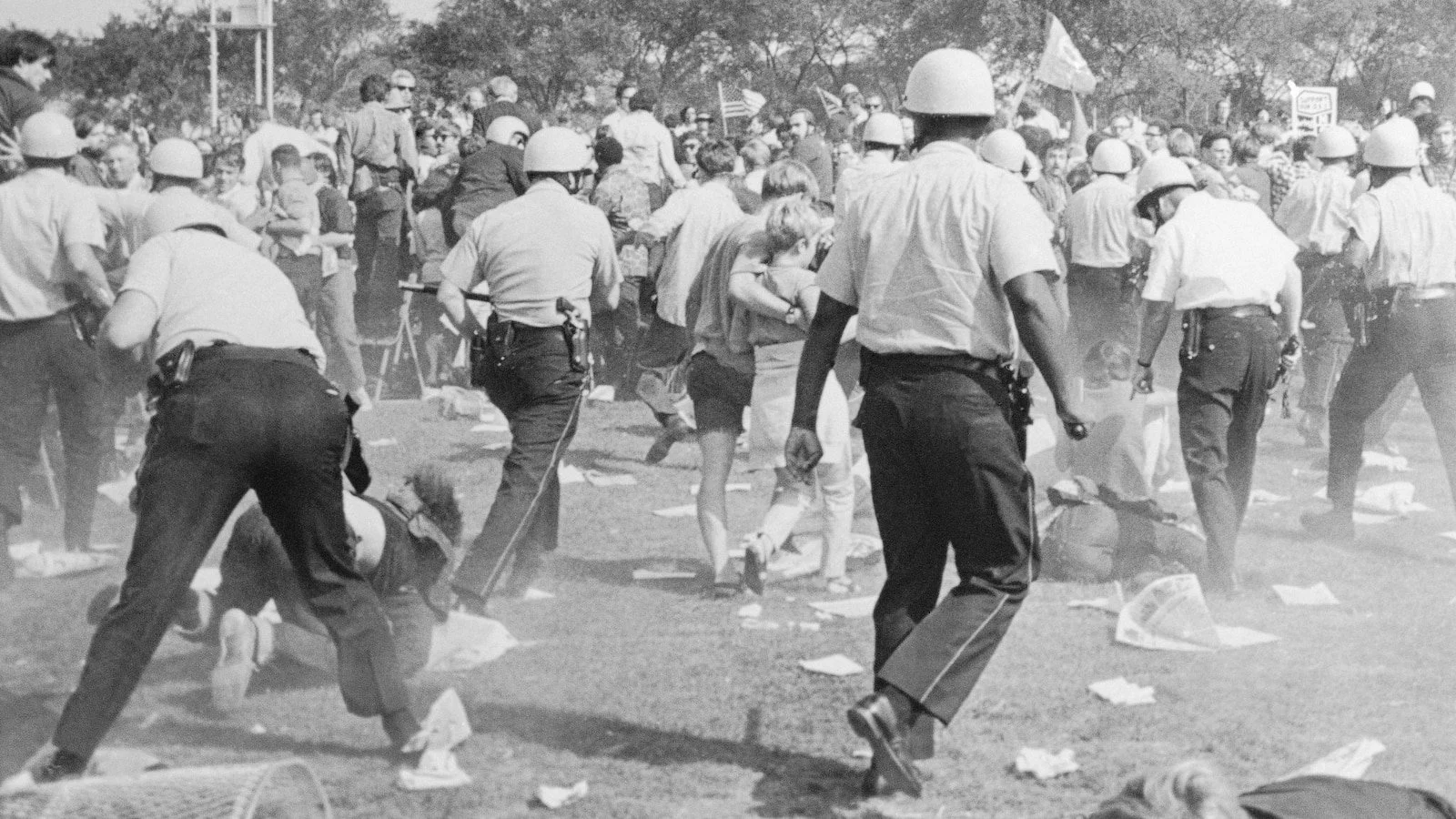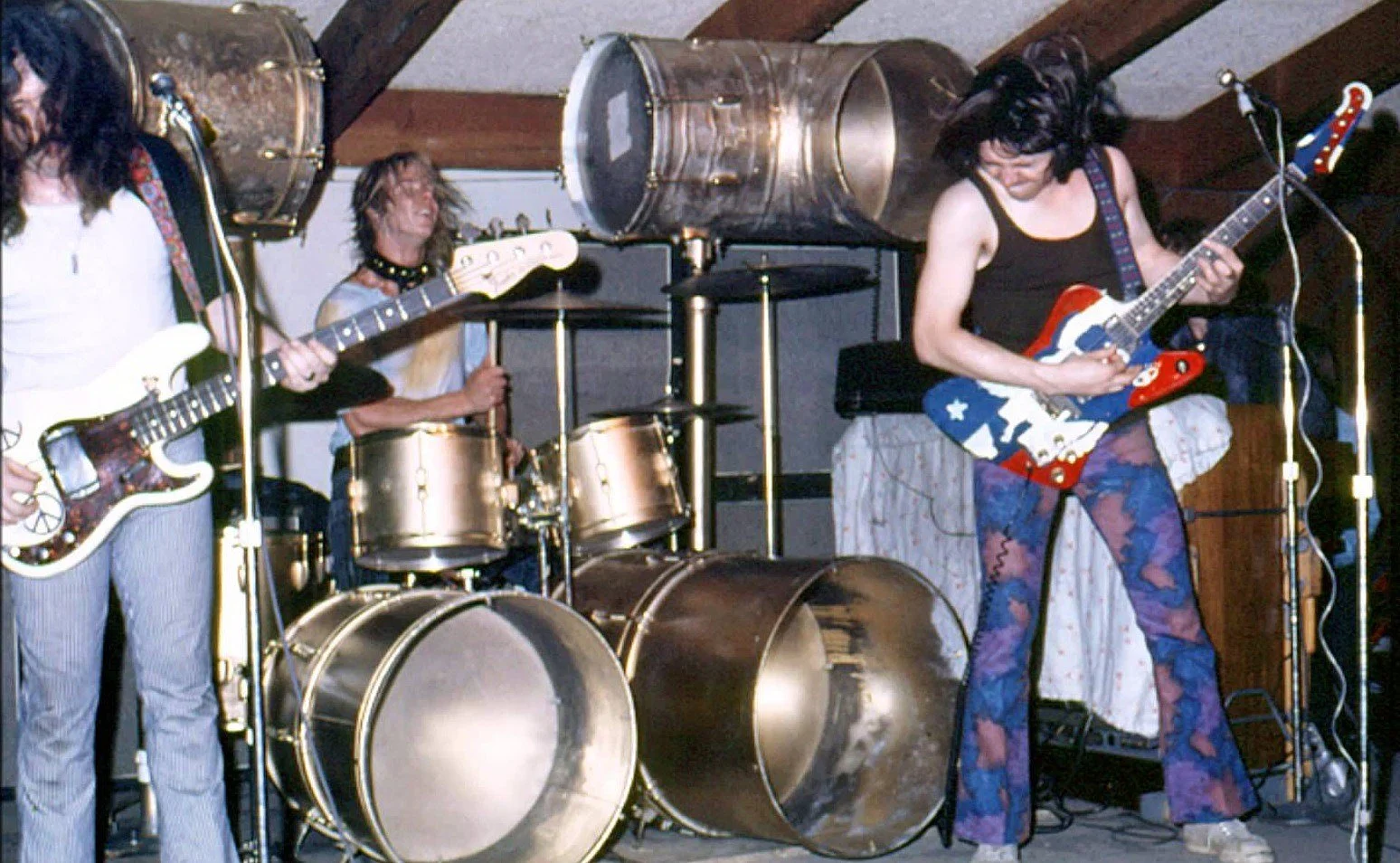The Vietnam War: The Medium is the Message (Part 1)
Chris Hemler, University Liggett School’s Director of Teaching and Learning with Technology will be speaking at The War Memorial August 27 from 6:00pm – 6:45pm. His SummerFest Lecture: Motown Meets the Movement is just prior to the concert by the Motown Museum’s Drey Skonie & the Klouds.
As Mr. Hemler will be largely discussing the process of understanding nuance in history through this topic, I will not be addressing Motown nor the artists he will be presenting.
For 20 years, 1955 – 1975, Americans were told the situation in Vietnam was supposedly not a war, it was merely an internal conflict between North and South Vietnam. This “conflict” saw over three million American young men forcefully dropped into the middle of it, over 58,000 of whom didn’t return home. Of the over 9,000,000 men and women who would serve in the U.S. Armed Forces during the war, 2,594,000 ended up in Vietnam, 1,857,304 were draftees, and the rest were volunteers.
For about the first 10 years, many patriotic young men signed up for service overseas. But public perception changed radically as the war wore on, between the messaging out of Washington and stories from Vietnam returnees. More troops were now missing or taken as POWs than in the mid-1950’s through the early–1960’s, and large numbers of young men aged 18 – 25 were being drafted after the Gulf of Tonkin Resolution in August of 1964. Lyndon B. Johnson needed a mechanism to accelerate the flow of troops into Vietnam, and the Resolution was the way this was achieved. There was an enormous pool of post-WWII baby boomers, late teens and young adults from which the Selective Service could choose, and most of them were influenced heavily by the non-establishment films and music of the time.
As a curious, media-devouring kid, I saw a huge array of images daily growing up with the Vietnam War: the never-ending protests; animated television arguments for and against; an avalanche of newspaper field coverage; the 1968 DNC riots; four dead students at Kent State; and the final chaotic evacuation from Saigon. Most memorably though were the years of seeing the three national nightly news programs finish their war-dominant reporting by scrolling names of American troops who had been killed that day in Vietnam. One long, slow, steady drip of dead men’s names. If the deceased were lucky, folks back home might glimpse a quick photo of them before seeing the next KIA’s name roll past. Then the anchors – Huntley, Brinkley, Cronkite, Reynolds, Smith, Reasoner - signed off. That day’s report of our dead had ended, and everyone went back to eating their dinner.
As much as the disturbing images, I remember the powerful music trying to cut through the pro-war political white noise, especially from about 1964 onward. The two musical genres that young Americans listened to that had much to say about the whole Vietnam experience were Folk and Rock.
Folk had several high-profile activist singer-songwriters who churned out tunes with either trenchant anti-war lyrics, or the public equated their “general protest” songs as also being strongly anti-Vietnam. Some of the more outspoken names were Bob Dylan (“Masters of War,” “The Times They Are a-Changin’”); Joan Baez (“A Song for David,” “Saigon Bride,” “Where Are You Now, My Son”); Pete Seeger (“Where Have All the Flowers Gone,” “Waist Deep in the Big Muddy,” “Turn! Turn! Turn,” “Ballad of the Fort Hood Three,” “If You Love Your Uncle Sam, Bring ‘Em Home”); John Prine (“Your Flag Decal Won’t Get You Into Heaven Anymore,” “Sam Stone”); Tom Paxton (“Lyndon Johnson Told the Nation,” “Peace Will Come,” “Jimmy Newman,” “Talking Vietnam Potluck Blues”); and most everything written by Phil Ochs (“Draft Dodger Rag,” “White Boots Matching in a Yellow Line,” “I’m Not Marching Anymore,” “The War is Over,” “Talking Vietnam”). Even Simon and Garfunkel’s “The Sound of Silence” and “7 O’Clock News/Silent Night” became associated with the anti-war movement.
But the rock ‘n’ roll side is where things truly got radical. Tunes ran the gamut from The Shirelles saccharine 1962 hit “Soldier Boy” (writers Florence Green and Luther Dixon) released early in the Vietnam campaign, to Black Sabbath’s explosive 1970 anthem “War Pigs.” As with folk music, some rock songs were overtly anti-war, and others were more nuanced: John Lennon and Yoko Ono (“Give Peace a Chance,” “Happy Xmas (War is Over),” “Imagine”); The Rolling Stones (“Gimme Shelter”); The Animals (“Sky Pilot”); The Byrds (“Draft Morning”); Buffalo Springfield (“For What It’s Worth”); Jefferson Airplane (“Volunteers,” “Wooden Ships”); The Doors (“Unknown Soldier”); Crosby, Stills, Nash & Young (“Ohio”); Donovan (Buffy Sainte-Marie’s “Universal Soldier”); and The Fugs (“Kill for Peace”) being prime examples. We were all waiting for the “Peace Train,” but it would be another four years after Cat Stevens’ optimistic hit before the Vietnam War would officially end – and not with actual peace for any of the belligerents.
The Animals (single bag)
Two of the most popular songs nationally associated with the war came out in 1965 when things started to ratchet up overseas. Vietnam War Navy vet Joe McDonald’s darkly satirical “I-Feel-Like-I’m-Fixin’-to-Die Rag” was first recorded in 1965 by his Country Joe and the Fish and later immortalized at 1969’s Woodstock during their 450,000-voice strong sing-along. Like many of the folk writers’ anti-Vietnam War tributes, its mix of upbeat tempo and very dark satirical lyrics guaranteed its place in music history. This was fun that practically everyone could enjoy!
The tune that many sources report polled as the #1 favorite among Vietnam veterans was by the prolific pop writers Barry Mann and Cynthia Weil, and was recorded by Newcastle, England’s British Invasion favorites, The Animals – “We Got to Get Out of This Place.” Another track not directly mentioning the war, Eric Burdon’s fiery vocals echoed American young men screaming to get out of their horrific situation in the jungle. At Vietnam veterans’ reunions, one might still find a similar cathartic vocal response if the song gets cranked up after a few brews with old brothers.
By 1967, the war’s KIA numbers jumped up to well over 11,000. There was plenty of unrest in the Motor City before and after the July ’67 rebellion, and it was heightened by some of the more extreme activists’ idea for ending the war by creating all-out revolution.
Detroit had a very animated and aggressive assemblage of Vietnam War objectors and social agitators. WABX, the early free-form progressive rock station and its DJs, was the slightly subversive main source of all things happening in music and with the local scene. The ABX Air Aces got the word out on-air and via anti-war, anti-establishment Love-Ins, Kite-Ins, and other sponsored events tied to live music.
Besides the larger venues (Cobo Arena, Ford Auditorium, Masonic Temple); local clubs (various Hideouts and Crow’s Nests, Fifth Dimension, Mummp, Silverbell, Red Carpet, etc.); and a few enlightened high schools (Southfield, Notre Dame); the two hippest concert venues operating were the Eastown Theater and the legendary Grande Ballroom. Both had amazing shows featuring the top British and American acts with local support, but the Grande had a secret weapon: their “house band” was the incendiary Motor City 5.
The MC5 throwing down, 1969 (©Leni Sinclair)
The MC5 were known to frequently blow many of the famous chart-topping acts off the stage with their high voltage live performances. The band consisted of five young Downriver (Lincoln Park) wannabe revolutionaries whose music was their weapon of choice. They were dedicated to all things anti-war, anti-establishment, anti-racism, anti-government, anti-capitalism, and anti-rules. They were also staunchly pro-high energy rock ‘n’ roll, pro-drugs, and pro-free love - all in large quantities. This stance ensured they and their families were rousted constantly by Detroit police, and all five had active FBI files.
In “Gotta Keep Movin’” penned by drummer Dennis Thompson, his observations included, “Young men fightin' for democracy, and sacrificed for mediocrity.” Among lead singer and prolific writer Rob Tyner’s targets were the draft (“Human Being Lawnmower”) and the Army, faux patriotism, police brutality, and other topical grievances (“American Ruse”). Tyner’s fierce live persona fronting the equally electrifying band spoke to every young Detroiters’ frustration, restlessness, and distrust in “white bread America.”
MC5’s Rob Tyner, 1969 (©Emil Bacilla)
Another John Sinclair benefit, 1970 (©Gary Grimshaw)
The MC5’s militant manager, John Sinclair, was also the White Panther Party’s founder so he was the perfect choice to spoon feed the anarchy – whenever he wasn’t in jail for possession. Besides the Grande, the band’s flame throwing reputation was made gigging nationally and playing locally at higher-profile events usually with tie-ins to ABX; radical underground publishers, the Fifth Estate; or the Detroit Artists Workshop / Trans-Love Energies Unlimited. Where there were angry kids protesting the Vietnam draft; government and police harassment; racism; pot busts; or civil rights issues, the MC5 were there testifying loudly and proudly on their behalf – and trouble would invariably follow.
August 25, 1968, the band was slated to play the Festival of Life, a large outdoor anti-war protest concert organized by the Yippies (Youth International Party) and MOBE (National Mobilization Committee to End the War in Vietnam) scheduled to kick off the DNC (Democratic National Convention) in Chicago. Earlier in ’68, both Martin Luther King Jr. (April) and Robert F. Kennedy (June) had been assassinated, and fallout from the My Lai Massacre (March) and the Tet Offensive (January - September) was still fresh; these tumultuous events weighed heavily on most Americans. Coming off Detroit’s ‘67 rebellion and the continuing anger over the escalating number of conscriptions and political double-talk, Chicago in August seemed like the perfect place to KICK OUT THE JAMS. MC5 music was absolute red meat for thousands of fired up protesters!
But once the band arrived in Chicago for their appearance, they immediately smelled trouble. Then-Mayor of Chicago, Richard M. Daley, took a combative public stance by ensuring that permits were not granted for most events, including the festival, and the stage not delivered. More importantly, an enormous amount of heavily armed police and Illinois National Guard troops were brought in to prowl the streets looking for any anti-war protesters. The MC5 snuck in an abbreviated set in Lincoln Park but bailed once they saw the Chicago PD moving through the crowd swinging billy clubs, per multiple band accounts. As frequent authority targets, they knew a very bad scene was brewing; they escaped and immediately drove back to Detroit.
Chicago Police during DNC anti-war protests, 1968 (©AP)
The carnage outside in the public parks and on Michigan Avenue spilled inside the International Amphitheatre (the convention center) and exclusive Conrad Hilton Hotel (delegate and candidate lodgings) over the next few days, which made for more unbelievable live television coverage. Top network newscasters, delegates, protestors, and others were assaulted or scooped up and hauled off to jail, all captured on camera and fed into our living rooms. Americans had never seen anything like this before. 1968 became the year much of the nation lost its trust in our top government figures and military leaders amid the realities of the Vietnam War.
Pandemonium on the DNC convention floor, 1968 (©AP)
Mayor Daley orders CBS News anchor Mike Wallace removed from DNC (©AP)
Besides the MC5’s music, Grand Funk Railroad’s “People, Let’s Stop the War,” and a smattering of Motown recordings, there was other significant anti-war action out of Detroit.
A rather surprising singer/songwriter launched a ballistic missile over the bow in 1968 that I believe still reigns as the very best of all anti-Vietnam War songs: Bob Seger’s “2+2=?.”
“Yes, it's true I am a young man,
But I'm old enough to kill
I don't wanna kill nobody,
But I must if you so will
And if I raise my hand in question,
You just say that I'm a fool
'Cause I got the gall to ask you
Can you maybe change the rule?
And you stand and call me upstart
Ask what answer can I find
I ain’t sayin’ I’m a genius
2+2 is on my mind”
This was certainly not our familiar Bob! This Bob Seger was absolutely enraged and called it like he saw it for millions of other young men.
“Well, I knew a guy in high school
Just an average friendly guy
And he had himself a girlfriend
And you made them say goodbye
Now he's buried in the mud
Of a foreign jungle land
And his girl just sits and cries
She just doesn't understand
So you say he died for freedom
Well, if he died to save your lies
Go ahead and call me yellow
2+2 is on my mind”
Seger was 22 years old and ripe for the draft when he wrote this scorcher. He questioned, as did all young males at the time, why he is was told he must kill people just because “it’s the rule.” He pled his case in the simplest of ways – just explain the logic of this to him.
What Seger captured, just like the television cameras, was the immense ugliness of what was being demanded of thousands of American teenage boys and men - that they must buy in to what was being peddled by our leaders. They knew this wasn’t about being patriotic. They weren’t saving the world from another mass murderer as in WWII when men signed up freely to fight tangible evil. This was an internal conflict in a country we were not a close ally of located over 8,500 miles away from Detroit.
Since 1955, Americans had been told by trusted authority figures we must be involved in someone else’s conflict; spend our money, send our young men. We had been spun stories that our military had to hit “acceptable kill numbers” arrived upon by a Ford Motors’ executive turned White House Defense Secretary (Robert McNamara). Our top military brass over there (Generals Creighton Abrams and William Westmoreland) reportedly acknowledged “we couldn’t win.” Legendary CBS television anchor Walter Cronkite broadcast that same opinion live from Vietnam after meeting with Gen. Abrams and visiting the front lines, prompting then-President Lyndon B. Johnson to bemoan, “If I’ve lost Cronkite, I’ve lost middle America.” Yet he and his successor, Richard M. Nixon, kept sending warm bodies to Vietnam year after year while thousands returned cold.
So, like millions of Americans in 1968, Citizen Bob demanded to know exactly “why?” I don’t believe we ever got a straight answer.
“All I know is that I'm young
And your rules they are old
If I've got to kill to live
Then there's something left untold
I'm no statesman, I'm no general
I'm no kid I'll never be
It's the rules, not the soldier
That I find real enemy
I'm no prophet, I'm no rebel
I'm just asking you why
I just want a simple answer
Why it is I've got to die
I'm a simple-minded guy
2+2 is on my mind”
Bob Seger System live, c1969-1970 (photographer unknown)
"2+2=?"
Written by Bob Seger © 1968, 1982 Gear Publishing Company
Listen to “2+2=?” from the Bob Seger System album Ramblin’ Gamblin’ Man
Raw footage of the MC5 playing the Festival of Life with police and protesters in Lincoln Park, IL; from guitarist Wayne Kramer’s official channel
1968 DNC documentary (original source unknown)
Next time in The Vietnam War: The Medium is the Message (Part II) we’ll investigate how the anti-war movement of the 1960’s motivated some of these same Detroit musicians to support our Vietnam War veterans when we speak with Mark Farner of Grand Funk Railroad.
Thanks to: Mike Boila (Gear Publishing Co.); Becky Tyner; Wayne Kramer; Gary Grimshaw; Emil Bacilla; Leni Sinclair; the Associated Press.








